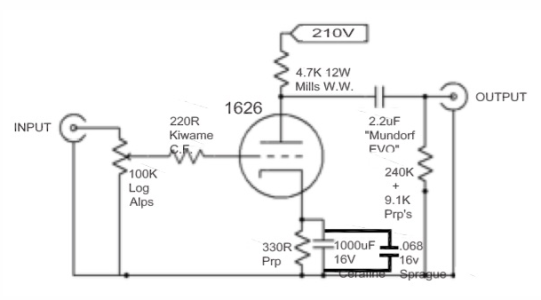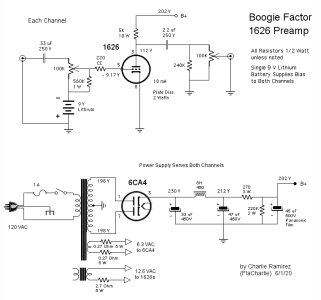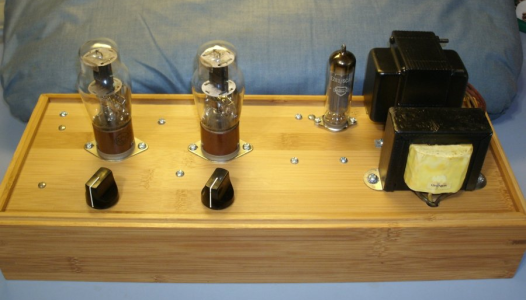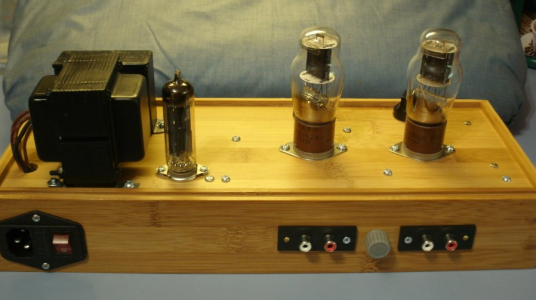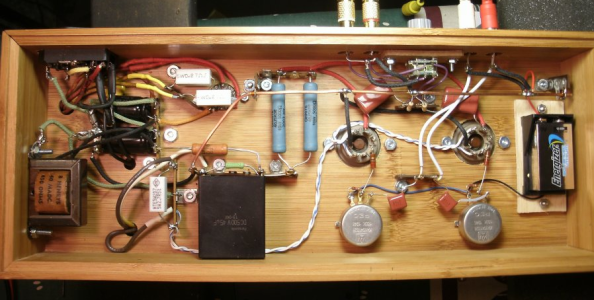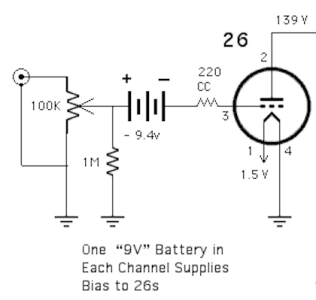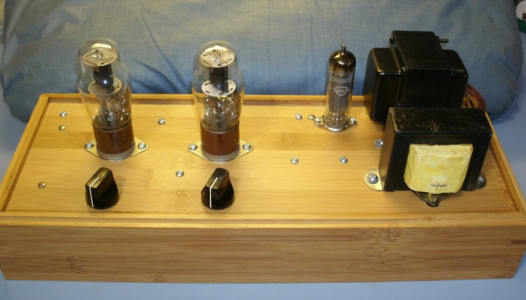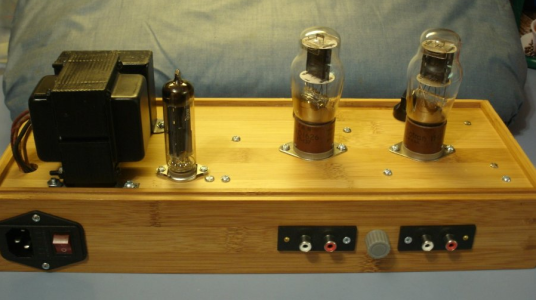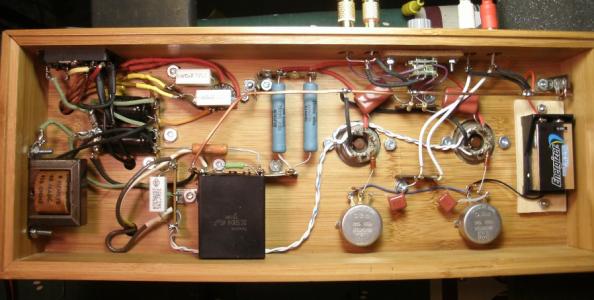FlaCharlie
Active Member
I mentioned this preamp in the thread about Class D amps and a couple of people seemed interested so this thread will offer some details. What I'll do here is to present an updated version of a thread I posted elsewhere in 2020, when I built this.
Some background: I first got interested in tube gear about 20 years ago and started buying vintage tube amps. I soon realized that I would need to learn how to restore / repair them myself because qualified techs were hard to find and paying them would be too expensive. So I collected a lot of vintage tube amps, learned to repair them and set up a very basic shop. Eventually, I got into building some DIY projects, which remains my focus today.
This preamp was the result of a sporadic breadboarding process during which I tried several different types of tubes, at least 8 and maybe as many as 12. I didn't keep a record.
Most amps don't really need any gain. Most all modern sources (CD, DAC) have line level outputs which is, nominally, 2v. And amps typically have input sensitivities that are less than 2v, sometimes even less than 1v, which is the amount of input signal needed to drive them to full power output. So you don't need any gain added to that 2v signal by a preamp in order to get full power. I'm talking about line level preamps here, not phono preamps, which do require significant gain.
And, unless you have a flea power amp and very inefficient speakers you're not running the amp anywhere close to full power either. So whatever volume control method you use is attenuating (reducing) the signal.
A so-called "passive preamp", which is typically just a simple volume pot, works fine with modern line level sources. But many people find that a "passive preamp" sounds a bit dry and sterile in some systems. And some people just prefer a different sound. So, while gain is not needed, other characteristics of a tube preamp can have a positive influence. Warmth and increased dynamics are often mentioned.
There are also tube buffers which don't produce any gain, but most products sold as "buffers" are not, it's become a marketing term. They're actually preamps which have gain, and usually a significant amount of gain. That's true of almost all commercial preamps, they tend to have way too much gain. To get one with very low gain you pretty much have to build one yourself.
The most obvious practical problem created by a high gain preamp is that your system might play at the loudest volume you're comfortable with when the volume control is set very low - maybe as low as the 9:00 position or so. That can make it difficult to make fine adjustments to the sound level. The wider the usable range of the volume control the easier it is to make fine adjustments.
I built a passive preamp using a stepped attenuator and it sounds very clean and clear. But I also wanted an active preamp that would provide the option of a small amount of gain along with a bit of tube flavor.
So my focus was on tubes with an amplification factor (mu) under 10. If you don't need gain why start with a tube that has a lot of gain? You'll just end up shunting more of the signal to ground.
I like building with tubes that are somewhat obscure, as long as they are relatively inexpensive and available, at least in DIY quantities. That's one of the advantages of DIY, the tubes don't need to be currently produced or available in large quantities and obscurity generally means they are cheap. Of course, preamp tubes aren't typically run very hard either, so they can last for many years, even decades.
A few of the tubes I tried were quite nice, including the Russian 2P29L and the 6V7G.
But the one that stood out to me was the 1626, which is a transmitting triode with a mu of 5. This is not a tube that most people think of as a preamp tube.
If the number sounds familiar it's probably due to it's popularity as a power tube in the famous Darling amp designed by Bob Danielak. I've never heard a Darling but it was quite popular with the DIY crowd years ago. It got excellent reviews but, with only 3/4 of a watt per channel, its appeal was somewhat limited.
Lots of 1626s were produced during WWII so there seems to be a healthy NOS supply. All the ones I've seen are in JAN (Joint Army / Navy) military boxes and they can typically be found for $15.
I got turned on to the 1626 by Andy Evans, who lives in London and posts on a couple of forums. Over the course of many years, I read numerous posts about his various preamp experiments. Some of his posts include brief descriptions of the sonics of the many tubes he's tried, one of which was the 1626.
He's mostly into directly heated tubes which I was hesitant to get involved with at the time because I kept reading reports about hum and microphonics and the methods builders were using to deal with those issues were often complex and expensive.
I build low cost, "bang for the buck", low parts count stuff so I went in a different direction. Despite the fact that Andy uses other preamp tubes, his descriptions of the 1626 were always so enthusiastic that I had to check them out.
Since I'm not real good at describing how things sound, here's some of Andy's comments:
"My system is heavily optimized for chamber and orchestral music. Bass is very clear but not punchy in a way that hits your stomach. Midrange is delicate rather than robust, treble is even more delicate. So you don't get slam and it doesn't "move air". . . . Then one day I tried the 1626 - now, I really love this tube. It had by far the best bass and a real 'boogie factor' - sounded great on rock and jazz. This has the best tone yet on jazz instruments - double bass, piano, cymbals are all very realistic indeed."
"I can say that of all the preamps I've made the one with the biggest boogie factor was the 1626. Man, that was so funky you'd put on Jimmy Smith and it would just hit you in your dancing feet - you'd get up and boogie across the room!"
"I substituted the 26 DHT and the two sounds couldn't be more different - where the 1626 was robust, the 26 was delicate, where the 1626 had the bass, the 26 had the air and highs. I decided to go with the 26 but still regret the 1626. For classical music I'd go with the 26, but if I just listened to rock and jazz I might prefer the 1626. I found both to be better than the 6SN7, and the 6SN7 (or preferably something like the 6P5GT) better than the 9 pins."
"I made one line stage with a 1626. This wasn't the greatest for classical music - lacked the finesse of a DHT. But by God it had BOOGIE FACTOR to such a point, you'd be dancing along to CDs - I kid you not . . . you couldn't sit still. I really regretted taking it out of my system."
"I can think of a few tubes with more delicate treble, and this is the chief reason I turned to other tubes. But it does something very well - it's a meaty sound, and quite involving. Kind of draws you into the music . . . a really foot-tapping sound."
"Some tubes are good at some things and some at others. When I had 1626s in my line stage, drumkit, hammond organ and bass were to die for, and grand piano was very nice. General sound was beefy, forward and very swinging on jazz - real "boogie factor". . . . It's a Jimmy Smith/Ray Charles kind of tube. Now I have 26s in there, and there's a wonderful delicacy . . . but less boogie factor."
His descriptions of the 1626 sound seemed to mesh well with my listening preferences so, of course, I had to try it. Sure enough, it stood out.
I started using Glo-Tone as a 'brand' of sorts when I was working on a guitar amp project with a friend many years back. I call this preamp the Boogie Factor in Andy's honor and with his blessing.
Schematic and pics to follow . . .
Some background: I first got interested in tube gear about 20 years ago and started buying vintage tube amps. I soon realized that I would need to learn how to restore / repair them myself because qualified techs were hard to find and paying them would be too expensive. So I collected a lot of vintage tube amps, learned to repair them and set up a very basic shop. Eventually, I got into building some DIY projects, which remains my focus today.
This preamp was the result of a sporadic breadboarding process during which I tried several different types of tubes, at least 8 and maybe as many as 12. I didn't keep a record.
Most amps don't really need any gain. Most all modern sources (CD, DAC) have line level outputs which is, nominally, 2v. And amps typically have input sensitivities that are less than 2v, sometimes even less than 1v, which is the amount of input signal needed to drive them to full power output. So you don't need any gain added to that 2v signal by a preamp in order to get full power. I'm talking about line level preamps here, not phono preamps, which do require significant gain.
And, unless you have a flea power amp and very inefficient speakers you're not running the amp anywhere close to full power either. So whatever volume control method you use is attenuating (reducing) the signal.
A so-called "passive preamp", which is typically just a simple volume pot, works fine with modern line level sources. But many people find that a "passive preamp" sounds a bit dry and sterile in some systems. And some people just prefer a different sound. So, while gain is not needed, other characteristics of a tube preamp can have a positive influence. Warmth and increased dynamics are often mentioned.
There are also tube buffers which don't produce any gain, but most products sold as "buffers" are not, it's become a marketing term. They're actually preamps which have gain, and usually a significant amount of gain. That's true of almost all commercial preamps, they tend to have way too much gain. To get one with very low gain you pretty much have to build one yourself.
The most obvious practical problem created by a high gain preamp is that your system might play at the loudest volume you're comfortable with when the volume control is set very low - maybe as low as the 9:00 position or so. That can make it difficult to make fine adjustments to the sound level. The wider the usable range of the volume control the easier it is to make fine adjustments.
I built a passive preamp using a stepped attenuator and it sounds very clean and clear. But I also wanted an active preamp that would provide the option of a small amount of gain along with a bit of tube flavor.
So my focus was on tubes with an amplification factor (mu) under 10. If you don't need gain why start with a tube that has a lot of gain? You'll just end up shunting more of the signal to ground.
I like building with tubes that are somewhat obscure, as long as they are relatively inexpensive and available, at least in DIY quantities. That's one of the advantages of DIY, the tubes don't need to be currently produced or available in large quantities and obscurity generally means they are cheap. Of course, preamp tubes aren't typically run very hard either, so they can last for many years, even decades.
A few of the tubes I tried were quite nice, including the Russian 2P29L and the 6V7G.
But the one that stood out to me was the 1626, which is a transmitting triode with a mu of 5. This is not a tube that most people think of as a preamp tube.
If the number sounds familiar it's probably due to it's popularity as a power tube in the famous Darling amp designed by Bob Danielak. I've never heard a Darling but it was quite popular with the DIY crowd years ago. It got excellent reviews but, with only 3/4 of a watt per channel, its appeal was somewhat limited.
Lots of 1626s were produced during WWII so there seems to be a healthy NOS supply. All the ones I've seen are in JAN (Joint Army / Navy) military boxes and they can typically be found for $15.
I got turned on to the 1626 by Andy Evans, who lives in London and posts on a couple of forums. Over the course of many years, I read numerous posts about his various preamp experiments. Some of his posts include brief descriptions of the sonics of the many tubes he's tried, one of which was the 1626.
He's mostly into directly heated tubes which I was hesitant to get involved with at the time because I kept reading reports about hum and microphonics and the methods builders were using to deal with those issues were often complex and expensive.
I build low cost, "bang for the buck", low parts count stuff so I went in a different direction. Despite the fact that Andy uses other preamp tubes, his descriptions of the 1626 were always so enthusiastic that I had to check them out.
Since I'm not real good at describing how things sound, here's some of Andy's comments:
"My system is heavily optimized for chamber and orchestral music. Bass is very clear but not punchy in a way that hits your stomach. Midrange is delicate rather than robust, treble is even more delicate. So you don't get slam and it doesn't "move air". . . . Then one day I tried the 1626 - now, I really love this tube. It had by far the best bass and a real 'boogie factor' - sounded great on rock and jazz. This has the best tone yet on jazz instruments - double bass, piano, cymbals are all very realistic indeed."
"I can say that of all the preamps I've made the one with the biggest boogie factor was the 1626. Man, that was so funky you'd put on Jimmy Smith and it would just hit you in your dancing feet - you'd get up and boogie across the room!"
"I substituted the 26 DHT and the two sounds couldn't be more different - where the 1626 was robust, the 26 was delicate, where the 1626 had the bass, the 26 had the air and highs. I decided to go with the 26 but still regret the 1626. For classical music I'd go with the 26, but if I just listened to rock and jazz I might prefer the 1626. I found both to be better than the 6SN7, and the 6SN7 (or preferably something like the 6P5GT) better than the 9 pins."
"I made one line stage with a 1626. This wasn't the greatest for classical music - lacked the finesse of a DHT. But by God it had BOOGIE FACTOR to such a point, you'd be dancing along to CDs - I kid you not . . . you couldn't sit still. I really regretted taking it out of my system."
"I can think of a few tubes with more delicate treble, and this is the chief reason I turned to other tubes. But it does something very well - it's a meaty sound, and quite involving. Kind of draws you into the music . . . a really foot-tapping sound."
"Some tubes are good at some things and some at others. When I had 1626s in my line stage, drumkit, hammond organ and bass were to die for, and grand piano was very nice. General sound was beefy, forward and very swinging on jazz - real "boogie factor". . . . It's a Jimmy Smith/Ray Charles kind of tube. Now I have 26s in there, and there's a wonderful delicacy . . . but less boogie factor."
His descriptions of the 1626 sound seemed to mesh well with my listening preferences so, of course, I had to try it. Sure enough, it stood out.
I started using Glo-Tone as a 'brand' of sorts when I was working on a guitar amp project with a friend many years back. I call this preamp the Boogie Factor in Andy's honor and with his blessing.
Schematic and pics to follow . . .


